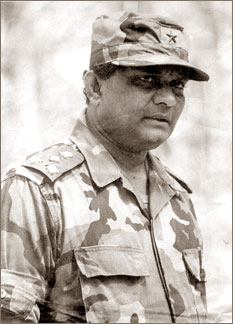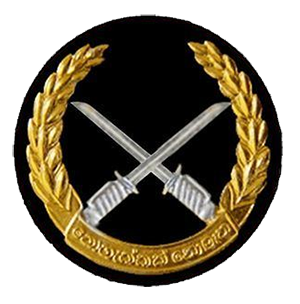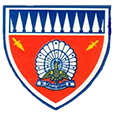
Lieutenant General Denzil Lakshman Kobbekaduwa, RWP, RSP, VSV, USP was a senior Sri Lankan Army officer who served in the 1971 Insurrection and the Sri Lankan Civil War.

Major General Vanigamuni Indrajith Vijeyakumar Mendis Wimalaratne, RWP, RSP, VSV, USP was a senior Sri Lanka Army officer. One of the most distinguished field commanders in Sri Lanka, Wimalaratne raised the Gajaba Regiment, he commanded the 1st Brigade during the Vadamarachchi Operation, he commanded the Amphibious Task Force Commander during Operation Balavegaya and was the Commander Security Forces – Jaffna at the time of his death in a land mine explosion at Point Arali in the Kayts Island while making preparations to re-capture Jaffna.

The Sri Lanka Army is the oldest and largest of the Sri Lanka Armed Forces. The army was officially established as the Ceylon Army in 1949, though the army traces its roots back in 1881 when Ceylon Light Infantry Volunteers was created; the army was renamed as the 'Sri Lanka Army' when Sri Lanka became a republic in 1972. In 2024, the Army had approximately 150,000 personnel.

Corporal Gamini Kularatne PWV, SLSR (S/34553) was a Sri Lankan soldier. He was the first recipient of the Parama Weera Vibhushanaya, the highest award for gallantry awarded by the Sri Lanka Army for his actions during the Elephant Pass Siege, in which he was killed.
Operation Pawan was the code name assigned to the operation by the Indian Peace Keeping Force (IPKF) to take control of Jaffna from the Liberation Tigers of Tamil Eelam (LTTE), better known as the Tamil Tigers, in late 1987 to enforce the disarmament of the LTTE as a part of the Indo-Sri Lanka Accord. In brutal fighting lasting about three weeks, the IPKF took control of the Jaffna Peninsula from the LTTE, something that the Sri Lankan Army had tried but failed to do. Supported by Indian Army tanks, helicopter gunships and heavy artillery, the IPKF routed the LTTE at the cost of 214 soldiers and officers.

The Commando Regiment is the commando formation of the Sri Lanka Army. The unit specializes in various roles including hostage rescue, counter-terrorism, unconventional warfare, special reconnaissance, counter-insurgency, and personnel recovery. It was formed in 1980 and is based in Ganemulla, a suburb of Colombo.

Eelam War II is the name given to the second phase of armed conflict between Sri Lankan military and the separatist Liberation Tigers of Tamil Eelam. The war started after the failure of peace talks between the Premadasa government and the LTTE. This phase of the war was initiated by the LTTE who massacred almost 600 Sinhalese and Muslim police personnel after they were ordered by the Premadasa government to surrender to the LTTE. The truce was broken on June 10, 1990, when the LTTE in October expelled all the 28,000 Muslims residing in Jaffna.

The Sri Lanka Armoured Corps (SLAC) provides the armour capability of the Sri Lanka Army, with vehicles such as the T-55AM2, and type 80/88 main battle tanks; the BMP infantry fighting vehicle; and the BTR-80, and WZ551 armoured personnel carriers. It comprises five regular armoured regiments, a volunteer regiment, and a regimental band. It has an independent Armoured Brigade and is headquartered at Rock House Army Camp, Colombo.

The Sri Lanka Sinha Regiment (SLSR) is an infantry regiment of the Sri Lanka Army; it is the second oldest infantry regiment in the army.

The Gemunu Watch (GW) ("King Dutugemunu's Own") is a infantry regiment of the Sri Lanka Army, formed with troops from the Ceylon Light Infantry and the Ceylon Sinha Regiment in 1962. It has been deployed in many major operations against the LTTE. It is made up of 14 regular units and 9 volunteer units. Headquartered at Kuruwita Army Camp, Ratnapura. It is named after one of the most famous Lankan Kings, King Dutugemunu.
Operation Liberation also known as the Vadamarachchi Operation was the military offensive carried out by the Sri Lankan Armed Forces in May and June 1987 to recapture the territory of Vadamarachchi in the Jaffna peninsula from the LTTE. At the time it was the largest combined services operation undertaken by the armed forces deploying multiple brigade-size formation, becoming the first conventional warfare engagement on Sri Lankan soil after the end of British colonial rule. The operation involved nearly 4,000 troops, supported by ground-attack aircraft, helicopter gunships and naval gun boats. The offensive achieved its primary objective, however operations were suspended when the Indian government dropped food supplies over Jaffna in Operation Poomalai on June 4, 1987, which prompted the Sri Lankan government to accept the Indo-Sri Lankan Accord.
The Battle of Mullaitivu, also known as the First Battle of Mullaitivu and codenamed Operation Unceasing Waves-1, was a battle between the militant Liberation Tigers of Tamil Eelam and the Sri Lankan military during the Sri Lankan Civil War for control of the military base in Mullaitivu in north-eastern Sri Lanka.
The Second Battle of Elephant Pass, was fought in April 2000 for the control of the Sri Lankan military base in Elephant Pass, Jaffna.

The First Battle of Elephant Pass was fought in July 1991 for the control of the Sri Lankan military base of Elephant Pass, which was of strategic importance as it linked the northern mainland known as Wanni with the Jaffna Peninsula. The battle was fought between troops of the Sri Lankan army and the Liberation Tigers of Tamil Eelam, commonly known as LTTE.

The Jeyanthan Regiment was an elite infantry formation of the LTTE. It was founded on 3 May 1993 and was initially trained under the leadership of Colonel Karuna Amman. It was the second oldest and most feared infantry unit of the Tamil Tigers. According to LTTE leader Velupillai Prabhakaran, the Sri Lanka Armed Forces feared the Jeyanthan Brigade the most and sought to avoid direct clashes with them. The soldiers in the unit all hailed from villages in the Eastern Province. Unlike the Charles Anthony Brigade which was only deployed in the North, the Jeyanthan Brigade was deployed in the East as well as the North and played an important role during Second Battle of Elephant Pass. The regiment was named after the LTTE's first Eastern Sea Black Tiger, Captain Jeyanthan, who destroyed a Sri Lankan Naval Patrol Vessel off the coast of Point Pedro on 4 May 1991. Prabhakaran inaugurated the unit on the 2nd death anniversary of Captain Jeyanthan in 1993.
Operation Thrividha Balaya was a combined military operation, the first of its kind, launched by the Sri Lankan Military in Jaffna. The Operation was carried out to break the siege of the Sri Lanka Army garrison of the old Dutch Jaffna Fort in Jaffna.
General Shavendra Silva, is a Sri Lanka Army four star general who is the current Chief of Defence Staff, the head of the Sri Lanka Armed Forces serving from 1 January 2020. He also served as the Commander of the Sri Lanka Army from 19 August 2019 to 31 May 2022. His other important appointments include, Chief of Staff of the army, Adjutant General and Director of Operations of the Army. During the Sri Lankan civil war he gained fame as the General Officer Commanding of the elite 58 Division. He had also served as the Deputy Permanent Representative to the United Nations Headquarters.
General Hamilton Wanasinghe, VSV was a full general in the Sri Lanka Army. He served as the 11th Commander of the Sri Lankan Army (1988–1991), third General Officer Commanding (GOC) of the Joint Operations Headquarters (JOH) (1991–1993) and Defence Secretary.

General L. D. E. Cecil Waidyaratne, VSV, USP was a Sri Lanka Army general. He was 12th Commander of the Sri Lankan Army and a former Sri Lankan Ambassador to Thailand.
Rear admiral Conan Anthony Mohan Jayamaha, RWP, VSV, USP, psc, SLN was a Sri Lankan Admiral. He was Commander, Northern Naval Area of the Sri Lanka Navy when he was killed from wounds sustained in a land mine explosion that killed 7 other senior military officers including Lieutenant General Denzil Kobbekaduwa in island of Kayts while making preparations for Operation Final Countdown the proposed invasion of the Jaffna Peninsula.










